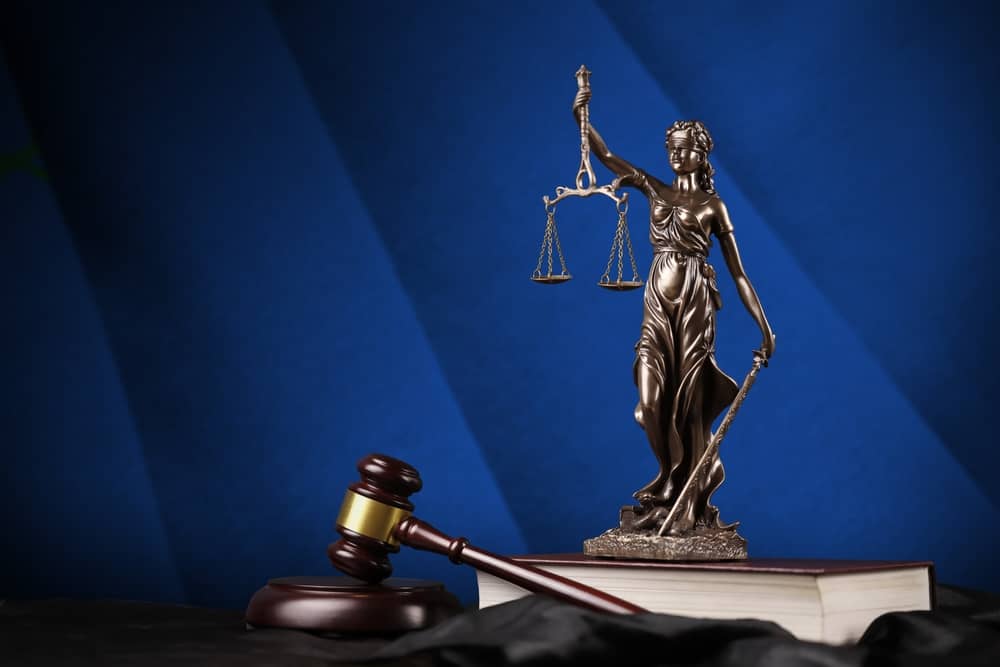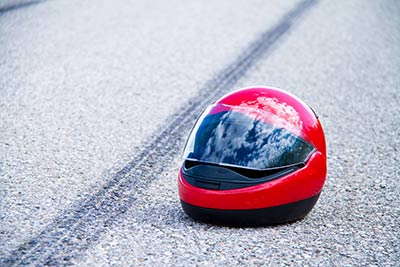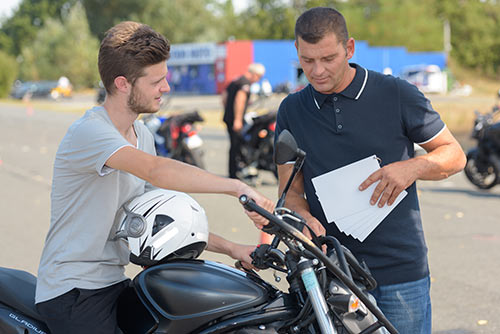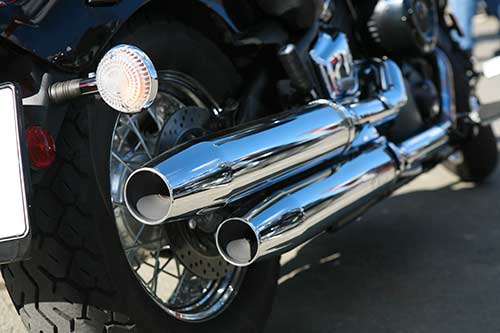Hundreds of motorcyclists traverse Nevada’s roads and highways every day. If operated appropriately, riding a motorcycle can be a fun and safe hobby. Unfortunately, other drivers do not always exercise the degree of care that they should while operating their vehicles. This can have devastating consequences for more vulnerable motorcycle riders, so if you or a loved one were injured in a motorcycle crash in Nevada, it is critical to speak with an experienced motorcycle accident attorney who can explain your legal options.
At the Ladah law firm, our top-rated Las Vegas motorcycle accident lawyers are dedicated to promoting safer roads and highways for bikers. Here, we have put together a comprehensive guide to the Nevada motorcycle laws and safety regulations. If you have any questions or concerns about our state’s motorcycle laws or if you are trying to figure out what to do after a motorcycle crash, please contact an experienced Las Vegas car accident lawyer at our local law firm for free legal guidance: (702) 252-0055.

Your Guide to Nevada Motorcycle Laws — Answers to the Most Frequently Asked Questions (FAQs)
Does Nevada Have a Motorcycle Curfew Law (Debunked)
Recently, a number of news sources reported that eleven states had agreed to pass and implement a law requiring motorcyclists to adhere to a curfew that barred motorcycle operation between the hours of 11:00 p.m. and 6:00 a.m. According to the article, Nevada was one of the states considering a curfew and would implement the law by July 3, 2016. It was quickly discovered, however, thatno such law existed< or was even being considered. While motorcyclists in Nevada must adhere to a number of laws and regulations, mandatory curfews are not one of them.
Nevada Motorcycle Laws Lane Splitting – Is it Legal?

In Nevada, lane splitting is not allowed, which means that motorcycle operators are not permitted to ride between moving or stationary vehicles that occupy adjacent lanes. Motorcyclists are also entitled to the full use of their traffic lane and so cannot pass or ride next to another vehicle that is traveling in the same lane. Two motorcycle riders are, however, permitted to share a lane if both parties consent beforehand.
Can You Split Lanes in Las Vegas?
No. There is no local exception to Nevada’s statewide prohibition on motorcycle lane splitting. Riders are not permitted to split lanes while operating their bike in Las Vegas. Though, similar to the state rules, motorcyclists are allowed to voluntarily share a lane with each other in Las Vegas — including on the Vegas Strip.
In Which States is it Legal to Split Lanes on a Motorcycle?
As of March of 2019, motorcycle lane splitting is banned in the majority of U.S. states. That being said, there are some major exceptions. For riders in Nevada, the most important exception is California. In California, it is legal for motorcyclists to split lanes as long as it is done in a safe and careful manner.
Nevada Motorcycle Helmet Laws – What are the Requirements?

Riders must always wear helmets in Nevada and if their motorcycle is not equipped with a windshield or windscreen, must also wear a protective shield or goggles. Helmets must also meet Department of Transportation (DOT) standards, which require that helmets weigh at least three pounds and be equipped with a protective inner lining, a secure chin strap, and a manufacturer’s label.
What Motorcycle Licenses are Required in Nevada?
In Nevada, residents are required to obtain a valid motorcycle license before they can legally operate their motorcycles. To qualify for a Class M license, a motorcyclist must:
- Complete an Application for Driving Privileges or ID Card at a Department of Motor Vehicles (DMV) office;
- Provide proof of identity, age, and Social Security Number;
- Be at least 16 years of age;
- Pass a vision test;
- Pass a general knowledge test about traffic laws, highway signs, and safe driving practices; and
- Pass a specific skills test created for motorcyclists.
The motorcycle-specific test includes a pre-trip inspection of the applicant’s motorcycle. The rider must also demonstrate a knowledge of his or her motorcycle’s controls and equipment, including the gear shift, brakes, starter, clutch, ignition, throttle, and choke. The examiner will also perform a cursory safety inspection and ensure that the applicant has a valid registration and insurance.
What are the Nevada Rules Regarding Motorcycle Passengers?
Operators of motorcycles are only legally allowed to carry one passenger. Furthermore, the passenger is only permitted to ride in one of the following positions:
- Behind the driver and astride a seat designed for two;
- Astride another seat that is firmly attached behind the driver; or
- In an attached sidecar.
All motorcycles designed or equipped for a passenger must also have adjustable footrests.
What is the Mandatory Equipment for a Motorcycle in Nevada?
To legally drive on Nevada roads and highways, operational motorcycles must bea href=”http://www.dmvnv.com/pdfforms/dlbookmotorcycle.pdf” rel=”nofollow”> >equipped with the following parts:
- At least one, but no more than two headlights;
- A red taillight that can be seen for 500 feet;
- A brake light that is visible in daylight up to 300 feet;
- At least one rear reflector visible for 300 feet when hit by a low beam;
- Both front and rear brakes;
- Front and rear electric turn signals on all motorcycles manufactured after January 1, 1973;
- A rear view mirror on each handlebar;
- Fenders on both the front and back wheels;
- Adjustable footrests;
- A horn; and
- A muffler.
Are Mirrors Required on Motorcycles in Nevada?
Yes. Under Nevada state law (NRS 486.311), motorcycles and similar vehicles must have the proper mirrors installed. More specifically, bikes should have at least two mirrors — one mounted on each handlebar — that allows them to see at least 200 meters behind them.
Nevada Turn Signal Laws — Does a Motorcycle Need to Have Turn Signals?
Yes. Under NRS 486.271, motorcycles and similar vehicles — including mopeds and other motorized bikes — must have turn signals. Turn signals should be reasonably clear and visible to other drivers.
What are the Nevada Motorcycle Handlebar Laws?
The most important Nevada law on handlebars is the height restriction. Motorcycles and mopeds should always be equipped with handlebars that extend no more than six inches above the top of the rider’s shoulders when the rider is in a seated position.
Nevada Motorcycle No Chase Law (What Is It?)
State and local law enforcement agencies have promulgated public safety rules regarding law enforcement and limits on high speed chases. You be wondering:
- What is the no chase law?
- Can police chase motorcycles? or
- What constitutes a high speed chase?
The answer is that it depends entirely on the specific circumstances. For example, the Las Vegas Metropolitan Police Department has rules against engaging in dangerous motorcycle pursuits. Of course, what is and what is not a dangerous pursuit will always be assessed by law enforcement officers on a case-by-case basis.
What are the Nevada Motorcycle Exhaust Laws?
Nevada has strict motorcycle exhaust laws. First, all motorcycles must have a proper muffler installed. In addition, there are regulations regarding how loud a motorcycle can be. What is the legal noise level from an exhaust? It depends, in part, on the speed of the bike. Motorcycles travelling 35 miles per hour or slower must always be lower than 82 decibels. Motorcycles travelling more than 35 miles per hour can be as loud as 86 decibels.
Is There a Noise Ordinance for Motorcycles?
All motorcyclists are required to comply with Nevada state exhaust laws. Beyond that, there may be additional local ordinances requiring lower levels of sound in certain communities or at certain times. If you have any questions about a city or county noise ordinance, be sure to check your local regulations.
What is the Motorcycle Lemon Law in Nevada?
Lemon laws provide a path to financial compensation for consumers who were sold a defective motor vehicle — including a defective motorcycle. Under Nevada motorcycle lemon law, a consumer who purchased a defective motorcycle or a motorcycle with a serious, previously unstated problem may be eligible to recover financial compensation for their damages. Under Nevada law, a motorcycle is a lemon only after a reasonable number of repair attempts have been made and problem still persists.
Does Nevada Have a Cooling Off Period?
As stated clearly by the Nevada Department of Motor Vehicles (DMV), Nevada does not have a right of rescission or “cooling off period”. A motorcycle purchase is generally final unless an individual agreement specifically indicates otherwise. Though, if there is a serious, previously unknowable problem with the bike, the buyer may have legal rights.
Contact a Dedicated Las Vegas Motorcycle Accident Attorney
Even a rider who follows all safety procedures and laws can become involved in a motorcycle crash, which can result in serious and even life-threatening injuries. Many of these injuries require multiple surgeries, long hospital stays, and expensive physical therapy, the costs of which can quickly overwhelm a victim’s finances. Fortunately, after a wreck, when injured parties can establish that another person’s negligence or recklessness caused or contributed to their accident, they may be able to collect compensation for their losses, so if you were injured or lost a loved one as a result of a motorcycle crash, contact the Ladah law firm at (702) 252-0055 to schedule a free consultation.


